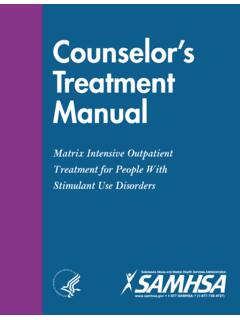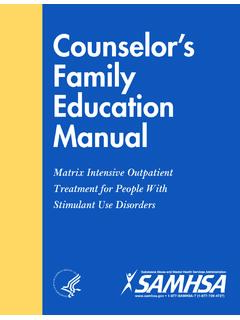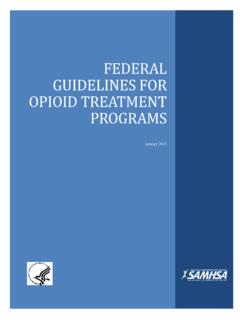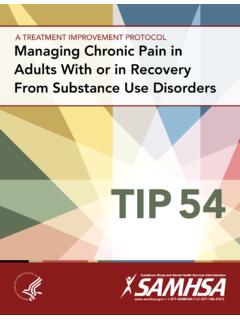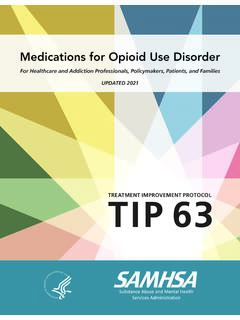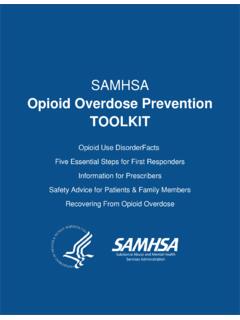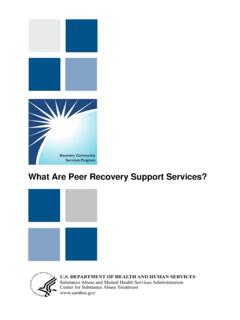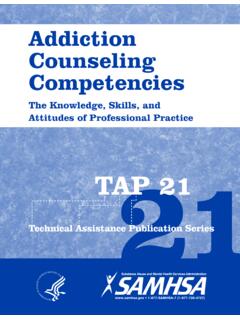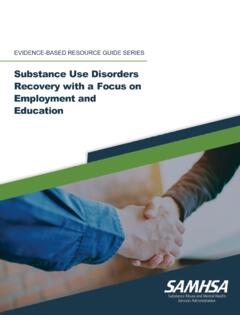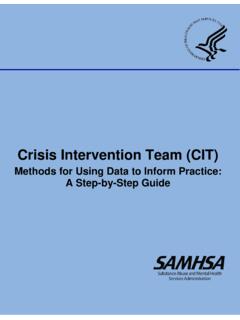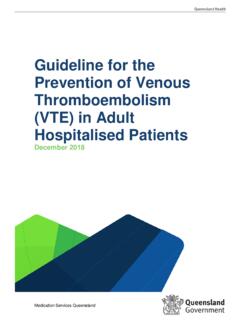Transcription of Medication for the Treatment of Alcohol Use Disorder: A ...
1 Medication for the Treatment of Alcohol Use Disorder: A Brief Guide Department of Health and Human Services Substance Abuse and Mental Health Services Administration Center for Substance Abuse Treatment Division of Pharmacologic Therapies 1 Choke Cherry Road Rockville, MD 20857. Acknowledgments This publication was prepared for the Substance Abuse and Mental Health Services Administration (SAMHSA) by JBS International, Inc. under contract number HHSS283200700003I/HHSS28342007T, with SAMHSA, Department of Health and Human Services (HHS). CDR Alina Salvatore, , , and LCDR Brandon T. Johnson, , served as the Contracting Officer Representatives. Disclaimer The views, opinions, and content expressed herein are the views of the authors and do not necessarily reflect the official position of SAMHSA, the National Institute on Alcohol Abuse and Alcoholism (NIAAA). or HHS. Nothing in this document constitutes an indirect or direct endorsement by SAMHSA, NIAAA, or HHS of any non-federal entity's products, services, or policies and any reference to a non-federal entity's products, services, or policies should not be construed as such.
2 No official support of or endorsement by SAMHSA, NIAAA, or HHS for the opinions, resources, and medications described is intended to be or should be inferred. The information presented in this document should not be considered medical advice and is not a substitute for individualized patient or client care and Treatment decisions. Public Domain Notice All materials appearing in this volume except those taken directly from copyrighted sources are in the public domain and may be reproduced or copied without permission from SAMHSA or the authors. Citation of the source is appreciated. However, this publication may not be reproduced or distributed for a fee without the specific, written authorization of the Office of Communications, SAMHSA, HHS. Electronic Access and Printed Copies This publication may be downloaded or ordered at Or call SAMHSA at 1 . 877-SAMHSA-7 (1-877-726-4727) (English and Espa ol). Recommended Citation Substance Abuse and Mental Health Services Administration and National Institute on Alcohol Abuse and Alcoholism, Medication for the Treatment of Alcohol Use Disorder: A Brief Guide.
3 HHS Publication No. (SMA) 15-4907. Rockville, MD: Substance Abuse and Mental Health Services Administration, 2015. Originating Office Division of Pharmacologic Therapies, Center for Substance Abuse Treatment , Substance Abuse and Mental Health Services Administration, 1 Choke Cherry Road, Rockville, MD 20857. HHS Publication No. (SMA) 15-4907. Printed 2015. i Medication for the Treatment of Alcohol Use Disorder: A Brief Guide CONTENTS. Introduction ..1. Considering Medications ..2. Screening and Assessing Patients ..7. Screening for Risky Alcohol Use ..7. Assessing the Need for Medication -Assisted Developing a Treatment Plan and Selecting a Setting Goals for Medication -Assisted Treatment ..9. Components of the Treatment Plan ..9. Educating the Patient and Obtaining Informed Consent ..9. Evaluating the Need for Medically Managed Detoxification ..10. Integrating Pharmacologic and Nonpharmacologic Therapies ..11. Addressing Co-Occurring Disorders ..11. Treating Adolescents and Young Adults.
4 12. Treating Pregnant and Postpartum Treating Older Adults ..12. Selecting a Medication ..13. Medication -Assisted Treatment ..18. Initiating Treatment with Disulfiram ..18. Initiating Treatment with Initiating Treatment with Acamprosate ..20. Treating People with Co-Occurring Disorders ..20. Monitoring Patient Progress ..20. Monitoring .. 20. Adjusting the Treatment Plan ..21. Summary .. 23. Appendix A: Members of the Consensus Panel, Staff, and Consultants ..24. Appendix B: Sources of Helpful Information ..26. Appendix C: Acknowledgments ..29. References .. 30. ii Medication for the Treatment of Alcohol Use Disorder: A Brief Guide INTRODUCTION. Current evidence shows that medications are underused in the Treatment of Alcohol use Alcohol Use Disorder: A Comparison disorder, including Alcohol abuse and Between DSM-IV and DSM-5. dependence.* This is of concern because of the high prevalence of Alcohol problems in the In May 2013, the American Psychiatric Association issued the 5th edition of the general ,2 For example, data show Diagnostic and Statistical Manual of Mental that an estimated 10 percent to 20 percent of Disorders (DSM-5).
5 Although there is patients seen in primary care or hospital considerable overlap between DSM-5 and settings have a diagnosable Alcohol use DSM-IV, the prior edition, there are several ,4 People who engage in risky drinking important differences: DSM IV described two often have physical and social problems related distinct disorders, Alcohol abuse and Alcohol to their Alcohol use. Problems with Alcohol dependence, with specific criteria for each. influence the incidence, course, and Treatment DSM-5 integrates the two DSM-IV disorders, of many other medical and psychiatric Alcohol abuse and Alcohol dependence, into a single disorder called Alcohol use disorder (AUD) with mild, moderate, and severe Yet, of the million people who met the subclassifications. Under DSM-5, anyone criteria for Alcohol dependence or abuse in meeting any two of the 11 criteria during the 2013, only a small subset ( million) received same 12-month period would receive a any type of formal Treatment (excluding mutual- diagnosis of AUD.)
6 The severity of an AUD . help groups) ranging from a single meeting mild, moderate, or severe is based on the number of criteria met: with a counselor to participation in a specialized Treatment Mild: The presence of 2 to 3 symptoms Moderate: The presence of 4 to 5. Although many experts in addiction believe that symptoms patients with moderate or severe Alcohol - Severe: The presence of 6 or more related problems should be offered Medication - symptoms assisted Treatment (MAT) on a routine basis,1. considerable resistance to the use of MAT The DSM-5 eliminates legal problems as a criterion, adds craving as a criterion for an AUD. persists. A diagnosis of Alcohol use disorder diagnosis and modifies some of the criteria continues to carry significant social exclusion, descriptions with updated language.. which affects both the individual who receives National Institute on Alcohol the diagnosis and the health care professionals Abuse and Alcoholism 6. to whom that individual may turn for care.
7 In part, the social exclusion continues because of To clarify the situation, the National Institute on a lack of understanding of Alcohol use disorder Alcohol Abuse and Alcoholism (NIAAA) and the as a treatable medical disorder2 even though, Substance Abuse and Mental Health Services more than 50 years ago, the American Medical Administration (SAMHSA) jointly convened a Association (AMA) affirmed that dependence on Consensus Panel on New and Emerging Alcohol and other drugs is a medical Pharmacotherapies for Alcohol Use Disorders The AMA encouraged physicians and other and Related Comorbidities (see Appendix A). clinicians, health care organizations, and The panel, which brought together experts in policymakers to frame all their activities and Alcohol research, clinical care, medical decisions in ways that reflect that fact. education, and public policy, reviewed current evidence on the effectiveness of available medications for the Treatment of Alcohol use disorders and developed guidance for the use *.
8 Within this document Alcohol abuse and Alcohol of medications in clinical The panel's dependence are used when discussing Medication indications guidance is summarized in this document. or research that is based upon this terminology. For a summary of important differences between DSM-IV and DSM-5, please see the box on this page. 1. Medication for the Treatment of Alcohol Use Disorder: A Brief Guide CONSIDERING MEDICATIONS. Direct involvement of physicians and other health Clinicians should consider prescribing one of care professionals in identifying and treating these medications when treating a patient who is Alcohol use disorder is possible, practical, and dependent on Alcohol or who has stopped necessary. The medications described here have drinking but is experiencing problems including been shown to be effective in, and are approved cravings or relapses. Patients with moderate or by the Food and Drug Administration (FDA) for, severe Alcohol use disorder, including those who the management of Alcohol dependence or the have physiologic dependence or who are prevention of relapse to Alcohol ,8,9,10,11 experiencing cravings and have not improved in Specifically: response to psychosocial approaches alone, are particularly strong candidates for Medication - Acamprosate calcium is indicated for the assisted ,2.
9 Maintenance of abstinence from Alcohol in patients dependent on Alcohol who are Medications should be prescribed as part of a abstinent at Treatment initiation. comprehensive Treatment approach that includes Disulfiram is an aid in the management of counseling and other psychosocial therapies selected patients who want to remain in a (through referral to a psychiatrist, psychologist, or state of enforced sobriety so that supportive professional counselor) and social supports and psychotherapeutic Treatment may be (through participation in Alcoholics Anonymous applied to best advantage. and other mutual-help programs).1,2. Oral naltrexone (naltrexone hydrochloride Table 1 summarizes information about each tablet) is indicated for the Treatment of Alcohol Medication approved by the FDA for the dependence. Treatment of Alcohol use disorder and/or the Extended-release injectable naltrexone is prevention of relapse to Alcohol use. indicated for the Treatment of Alcohol dependence in patients who have been able to abstain from Alcohol in an outpatient setting.
10 2. Medication for the Treatment of Alcohol Use Disorder: A Brief Guide TABLE 1: Medications Approved for Use in the Treatment of Alcohol Use Disorder . Naltrexone Disulfiram Acamprosate oral and extended-release injectable delayed-release tablets formulations Frequency of Daily Daily (oral) or monthly (extended-release Three times per day Administration injectable). Principal Action When taken in combination with Alcohol , Blocks opiate receptors that are involved in the Is thought to reduce symptoms of protracted causes a significant physical reaction, rewarding effects of drinking and craving for abstinence by counteracting the imbalance involving nausea/vomiting, flushing, and Alcohol . between the glutamatergic and GABA ergic heart palpitations. The knowledge that such systems associated with chronic Alcohol reactions are likely if Alcohol is consumed Extended-release injectable naltrexone is exposure and Alcohol withdrawal. acts as a deterrent to drinking. administered every 4 weeks, thereby minimizing opportunities for nonadherence, as compared with Given sufficient amounts of Alcohol in the daily oral ingestion.
